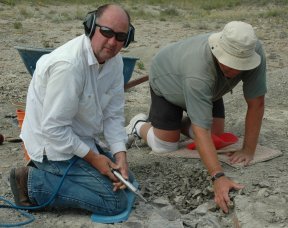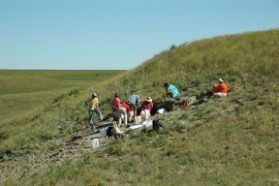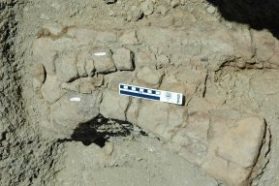News Detective: Digging for Bones

Unearthing fossils is hard, gritty work. A lot of the time, it’s monotonous. But the excitement of making a rare discovery can make the experience worthwhile.
In July, I spent 6 days camping out and digging for dinosaur bones and other fossils at the 5E Ranch in Montana, about 100 miles (160 kilometers) north of Billings.
On the first day, we learned how to excavate fossils using simple hand tools. We used awls, which resemble thick ice picks, to pry apart the layers of soft, crumbly rock in which fossils previously had been found. Then, we used wide, stiff paintbrushes to wipe away chunks of rock so that we could inspect the area for fossils. We had to work very carefully, making sure that we didn’t damage any bones that were still hidden in the soil.
When done this way, unearthing fossils is slow going. Poke, pry, brush away a handful of rock chips, look for fossils. Poke, pry, sweep, and repeat. Fill a gallon-size scoop, then dump it in a bucket.
Six or eight scoops fill a bucket, and six or eight buckets fill a wheelbarrow. Roll the wheelbarrow downhill, empty it, and return to your little section of the dig site. Fill, roll, empty, and repeat. A ton of rock makes a pile much smaller than you would think.
 |
| Volunteers unearth the remains of a stegosaur. |
| Sid Perkins |
It can be boring. On the first day, a dozen or so of us dug for more than 6 hours. The only fossils we found were a small piece of a dinosaur tooth and a 20-centimeter-long piece of a rib.
On the second day, a few of us went to excavate fossils at a site on a neighboring ranch. There, the rock was much harder, and our hand tools were almost useless.
So, we used air hammers—small, chisel-like tools powered by compressed air. Wow! These tools really shattered the rock. However, because air hammers are very powerful, we had to be especially careful not to break any fossils.
Some members of the dig team spent part of the second day looking for new fossil sites. They discovered bones from a stegosaur on a hillside about 150 meters away from the original site.
On the last day of our dig, there was a frenzy of activity at the stegosaur site. Some team members sketched the layout of the bones. Others used compasses to determine direction and measuring tapes to pinpoint objects. This information will help scientists reassemble the bones after they’re removed from the ground.
 |
| Taking measurements of a stegosaur’s remains. |
| Sid Perkins |
After unearthing the small bones, we wrapped them in aluminum foil and labeled them. We wrapped the larger bones in aluminum foil, several layers of wet paper towels, and an outer coating of plaster-soaked burlap.
Then it was time to get the bones onto the truck. This required more teamwork. Carrying a several-hundred-pound lump of stone, bone, and plaster down a steep hill and loading it into the back of a truck is harder than it sounds!
After we had finished our job, we jumped into our cars and headed back to Billings. There, for the first time in a week, we took hot showers. It felt really good.
For a detailed diary of my Montana fossil-digging experience, see “Bone Hunt.”—Sid Perkins